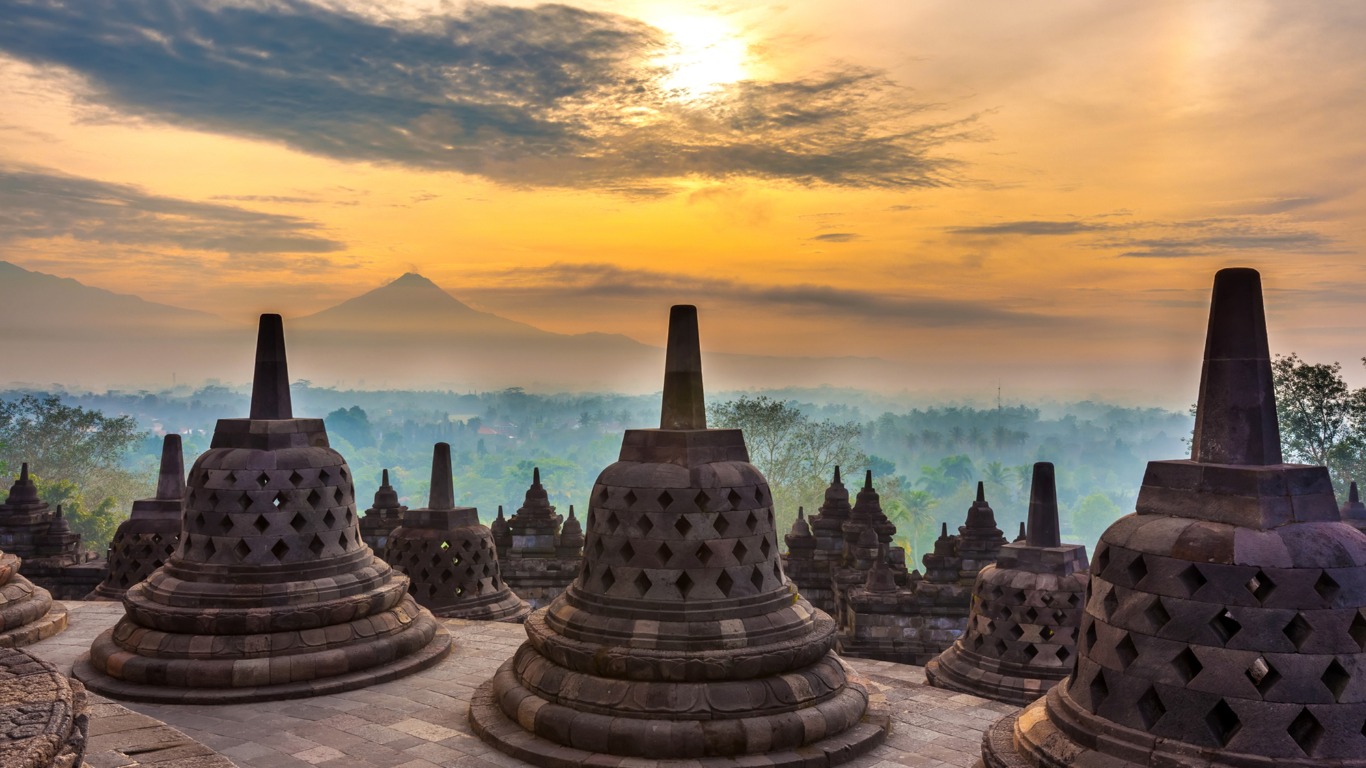Imagine a landscape shrouded in the pre-dawn mist, where ancient stones slowly emerge from the emerald embrace of the Javanese jungle, revealing a colossal monument unlike any other. This is Borobudur, the largest Buddhist temple in the world, a breathtaking testament to human ingenuity and spiritual devotion. For many, a trip to Indonesia isn’t complete without experiencing its profound presence. But is Borobudur temple worth visiting? Absolutely, and in the paragraphs that follow, I’ll unveil why this UNESCO World Heritage site is not just a destination, but a journey for the soul, promising an unforgettable travel experience that resonates long after you’ve returned home.
The Ancient Heart of Java: A Tapestry of Stone and Spirit
Stepping onto the sacred grounds of Borobudur is like traveling back in time, to an era where faith sculpted mountains of stone into narratives of enlightenment. The atmosphere here is palpable – a serene hush often broken only by the chirping of cicadas or the distant call to prayer from a nearby village. As you ascend its nine levels, each terrace tells a story through over 2,672 intricate relief panels, depicting the life of Buddha and Buddhist teachings. Can you imagine the sheer dedication it took to carve such detailed sagas into volcanic rock? It’s mind-boggling.
The natural scenery surrounding Borobudur is equally captivating. Lush, fertile plains stretch out in every direction, dotted with traditional Javanese homes and verdant rice paddies. In the distance, the majestic peaks of Mount Merapi and Mount Merbabu often pierce through the clouds, providing a dramatic, almost theatrical backdrop to this ancient wonder. The golden hour, particularly at sunrise, bathes the entire complex in a soft, ethereal glow, transforming the hundreds of Dhyani Buddha statues and bell-shaped stupas into silhouettes of pure magic. This isn’t just sightseeing; it’s an immersion into a living landscape where nature and spirituality intertwine seamlessly.
Experiencing Borobudur: Beyond the Stones

While the temple itself is the undeniable star, the Borobudur experience extends far beyond its intricate carvings.
The Iconic Sunrise Climb: This is the quintessential Borobudur experience, and for good reason. Waking before dawn and ascending the temple’s terraces as the first rays of light paint the sky in hues of orange, pink, and purple is nothing short of transformative. As the mist clears and the hundreds of stupas and Buddha statues come into sharp relief against the awakening landscape, you’ll understand why this moment is etched into the memories of countless travelers. It’s a spiritual awakening, even for the non-religious, offering a unique perspective on human resilience and aspiration.
Delving into Local Culture: Around Borobudur, life unfolds at a gentle, unhurried pace. Consider renting a bicycle or taking a local becak (pedicab) tour through the surrounding villages. You can witness traditional batik making, observe the intricate process of making luwak coffee, or even try your hand at pottery. These intimate encounters offer a genuine glimpse into Javanese hospitality and daily life, creating connections that enrich your travel narrative. Don’t forget to sample local delicacies; the area is known for its Gudeg (young jackfruit stew), and the sweet Bakpia Pathok pastries make for a delightful snack or souvenir.
Souvenir Hunting: From intricately carved wooden miniatures of Borobudur stupas to beautiful hand-printed batik fabrics and traditional puppets, there’s no shortage of unique mementos to bring home. Support local artisans by purchasing directly from village stalls or small shops, ensuring your souvenir has a story behind it.
Practicalities for Your Pilgrimage
Ready to plan your own Borobudur adventure? Here are some essential tips:
- Best Time to Visit: The dry season (April to October) offers the most pleasant weather. To experience the legendary sunrise, aim for an early morning visit. The crowds are typically smaller right after sunrise or late in the afternoon.
- How to Get There: Borobudur is located in Central Java, approximately 40 km northwest of Yogyakarta. Yogyakarta (JOG) is the closest major airport. From Yogyakarta, you can hire a private car with a driver (around 1-1.5 hours), take a local bus (cheapest, but longer journey), or join an organized tour, which often includes hotel pick-up and drop-off.
- Entrance Fees: There are separate fees for foreigners and domestic tourists, and often a higher fee for the sunrise tour (which grants early access). It’s advisable to check the official Borobudur website or a reliable travel guide for the most up-to-date pricing. Children usually have reduced rates.
- What to Wear: Dress respectfully. While there’s no strict dress code for general entry, it’s customary to wear modest clothing that covers your shoulders and knees. Comfortable walking shoes are a must, as you’ll be doing a lot of climbing and exploring.
- Nearby Attractions: Combine your Borobudur visit with other incredible sites. The magnificent Hindu temples of Prambanan, another UNESCO site, are just an hour’s drive away. Explore the vibrant city of Yogyakarta with its Royal Palace (Keraton), Water Castle (Taman Sari), and bustling Malioboro Street. For the adventurous, a jeep tour up the slopes of Mount Merapi offers a thrilling natural experience.
Conclusion: A Journey That Stays With You
Borobudur isn’t merely an ancient monument; it’s a profound experience, a spiritual odyssey, and an architectural marvel that continues to inspire awe. From the serene climb to witness a legendary sunrise to the quiet contemplation amidst its stone Buddhas, and the engaging encounters with local culture, every moment spent here is a step on a truly unique travel journey. So, pack your bags, open your heart, and prepare to be moved by the timeless beauty and spiritual grandeur of Borobudur. It’s more than worth visiting; it’s an essential chapter in any dedicated traveler’s story.


